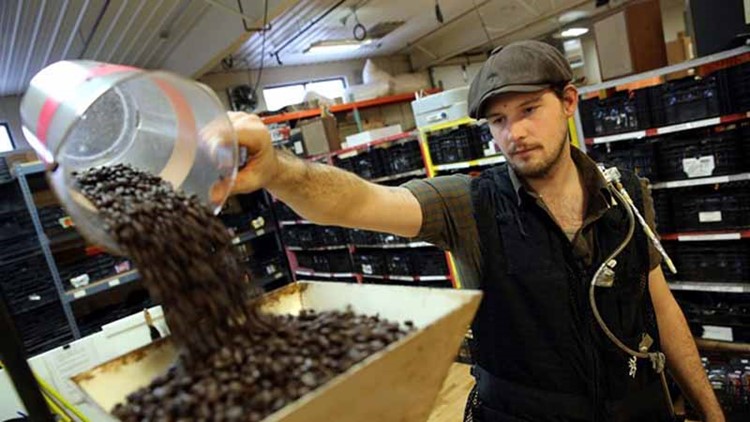MILWAUKEE, Wisc. -- For the last two years, a small group of doctors and scientists with the U.S. Centers for Disease Control and Prevention have spent their days in coffee shops around the country.
They weren’t there sipping their morning cup of Joe. Their mission? To protect the health of the rapidly growing number of workers who make their living roasting, grinding, packaging and serving coffee.
The doctors and scientists gathered information from corner cafés with a lone roasting oven to large-scale processors with more than 150 workers. They assessed the various threats — primarily the air — and gave breathing and other medical tests to employees.
Their preliminary findings, based on 11 site reports that have been released in recent months, indicate widespread problems that jeopardize employee health across the estimated $74 billion industry.
In several of the facilities, workers were exposed to more than four or five times the recommended level of diacetyl, a dangerous compound known for rapidly destroying lungs.
The CDC found dozens of workers with abnormal breathing tests, and workplaces where cases of respiratory illness were more than twice the rate found in the general population — a discovery that suggests ties to worksite environments.
The agency is due to release nine more reports in the coming months and is aggregating the data from all 20 facilities and more than 450 workers to pinpoint job tasks that are associated with the most harm.
“This is an emerging issue,” said Rachel Bailey, a medical officer with the National Institute for Occupational Safety and Health, the division of CDC conducting the study. “There are a lot of things coffee companies can do right away to protect their workers.”
NIOSH does not disclose the names of the companies where it conducts its research, known as “Health Hazard Evaluations,” to protect the privacy of the companies which all invited the agency in to help identify risks to workers. The agency does not have enforcement authority for workplace safety, but makes recommendations on standards to OSHA, the Occupational Safety and Health Administration.
The CDC’s probe into the coffee industry followed a 2015 investigation by the Milwaukee Journal Sentinel that exposed how naturally occurring diacetyl and 2,3-pentanedione endanger the roughly 750,000 workers working in coffee operations in the U.S.
The importance of the issue continues to grow as the industry booms with boutique roasters. The overall number of establishments that list coffee or tea manufacturing as their primary business has climbed 42% since 2014, according to figures from the U.S. Bureau of Labor Statistics.
NIOSH, the division of the CDC studying the coffee facilities, recommends workers not be exposed to an average of more than 5 parts per billion of diacetyl over an 8-hour workday, and 9.3 parts per billion of 2,3-pentanedione. The standard applies to both the naturally occurring and synthetically made chemicals.
The recommendations do not apply to roasting, grinding or brewing coffee at home. Nor do they address exposures experienced by customers in cafes. The limits pertain to occupational environments only.
Data in the new NIOSH on-site reports, published between January 2017 and April 2018, show workers were exposed to levels exceeding the federal recommendation in 10 of the 11 facilities. At two operations, the levels reached 25 and 26 parts per billion. Asthma was common, along with eyes and nose irritation.
In one plant that employs 150 workers, 16 of 38 workers had abnormal results in breathing tests for small airways diseases.
“Our findings of upper and lower respiratory symptoms…and abnormalities in lung function testing…suggest a burden of respiratory problems in this workforce,” the February 2018 report from a visit to the company, says.
Steps companies can take
There is no way for coffee companies to know the levels of the chemicals without having the air tested by an industrial hygienist —something NIOSH suggests they do. Even places with little odor and seemingly large, airy spaces have been found with elevated levels.
Still, companies can do a few things to immediately reduce the risk of exposure, Bailey said.
Among the most important: Ensure good ventilation.
Bailey said that doesn’t mean simply opening doors or installing fans, which just circulate the fumes. Proper outside air exchange is critical and coffee companies should have ventilation experts assess their set up.
“We’ve seen some places that have no ventilation, whatsoever,” Bailey said.
Local exhaust systems can also pull the toxic fumes away from workers’ lungs. In areas where coffee is ground and packaged — and levels of diacetyl and 2,3-pentanedione are among the highest — local exhaust would greatly reduce exposure, Bailey said.
Additionally, companies should implement medical surveillance programs to monitor employees’ lung functioning. Bailey encouraged workers to participate in the programs.
Workers should also keep their faces away from the bins when scooping coffee beans. As the beans release gases in the containers, the dangerous fumes build up. Then when lids are opened, workers can be blasted with extremely high levels of chemicals.
“We think those peak exposures are very important,” Bailey said. “We’ll know more once we get all the data aggregated.”
Read the investigation
To read the Journal Sentinel's Gasping for Action investigation, into lung hazards tied to chemicals in the coffee-roasting process, go to jsonline.com/gaspingforaction.



